By Chris Willis
Most firefighters would think barns hold nothing but farm equipment and livestock; however, sometimes people live inside these structures, and in some cases they may contain crime scenes such as in clandestine drugs labs. In today’s world, we can’t go about thinking that these same structures are still the same as they traditionally were: a building that houses beef cows. In reality, they may have a second-floor loft with a full living area or a basement with a meth lab.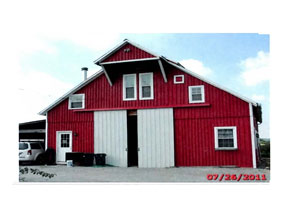
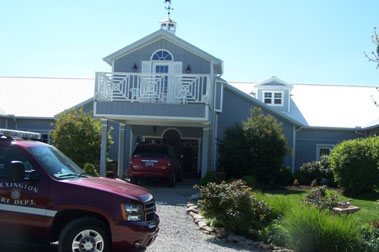

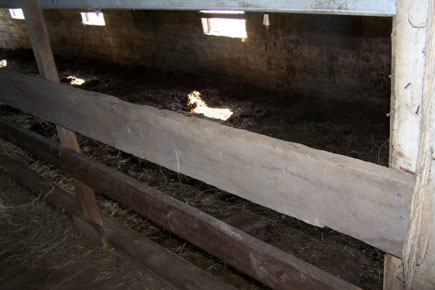
(1-4) There are many different types of barns firefighters may encounter in rural areas.
There are many styles of barns out there. This article deals with agricultural barns; the subsequent article will deal with barns with dual purposes.
The typical uses of agricultural barns include housing for livestock; storage of hay, feed, or other crops; and storage of farm equipment such as tractors. These types of buildings date back to the turn of the century and exist today.
Some of the things firefighters may encounter include natural foliage material such as hay or tobacco. Hay can be stored loose-square baled or round baled. Tobacco may be stored on overhead beams, trees that have been cut and laid between rails from the very top of the barn to the ground (photo 5), thereby providing room to pull in a tractor with a trailer.
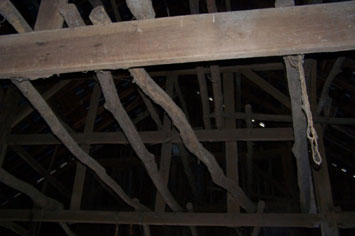
(5)
There is also the potential to stumble across materials such as rubber, diesel fuel/gasoline, and plastics, such as in the case of tractor parts. Many of these barns were built of heavy timber posts set in the ground; lightweight wood is built onto these posts. You may find lofts that contain hay tools and other instruments.
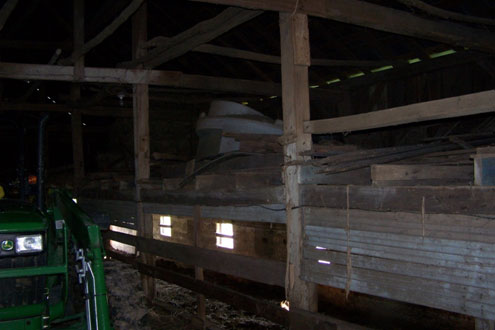
(6)
One of the things that some barns have in common with modern housing is the electrical system. These systems have circuit breaker boxes and fuse panels and are set up just like houses (photo 7), with full 110v electric outlets and so forth.
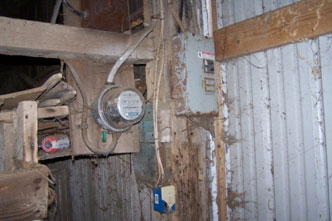
(7)
BARN DANGERS
Firefighters face a number of problems and hazards at these structures. These barns have a wood interior shell. Under heat conditions, they fail quickly, starting with the secondary beams. In the above photo, the breaker box is mounted on the main beam, but notice the smaller-diameter wood that is connected to the main beam. The other problem with the construction is the floors. In this particular barn (photo 8), you can see that it has a floor made from wooden planks, which creates a void space underneath the floor. Storing a tractor and other equipment on that floor is similar to a roof that has a HVAC system on it. When water and heat are introduced, the floor will weaken. In some cases, the floors are merely dirt, in which case firefighters don’t have to worry about fire getting under them.

(8)
The next problem is the fuel load inside the barns. Typically, these structures contain a high fuel load that consists of the organic material. This material may be all around you and on the floor; in the case of wooden-plank floors, it can decrease the time you can stay on that floor before it heats to its flash point.
Are People Living Here?
How are we supposed to know if barns in our district have people living in them? There are some things to look for from the get go. Work with law enforcement to identify any problem areas in your district. As an example, I recall a string of burglaries affecting local farmers. Thieves were not simply stealing gas or copper; they were stealing vegetables. This may sound like a “Mayberry problem,” but if you have barns in your district, the homeless may take up residence in them.
Another thing to look for when performing your 360° walk-around is cut locks. If you go to force the door on one of these structures, be wary. In addition, look for “fresh” trash, such as newly opened soda cans or cans of beans and the like (for example, older trash-like cans will be faded from exposure). Look for windows above the ground floor, which may indicate either a loft or living quarters.
At times, it’s very hard to determine if someone is staying in these structures. Many structures are open to the outside–they are not locked or don’t have any doors and are simply being used to protect items from the weather. Take precautions any time you get dispatched to barn fires. When preplanning your response area, get out and do some walk-throughs of these structures .
How do you determine what’s in these barns? Besides doing walk-throughs, you can try sending out forms asking owners for information. Using the farmers to help preplanning can be very useful and beneficial to your operation. They will give you the quickest and most useful information if asked the right questions. On such forms, consider asking what they store in their barn and whether they keep any fertilizer and fuel in the barns. If so, what type of containers is the fuel stored in-plastic or metal, for example.
Strategies and Tactics
Tactics and strategies for these old tinder boxes may vary from aggressive interior attack to aggressive defensive or passive defensive operations.
When considering an aggressive interior attack, decide as soon as the call comes in if you want to go this route. If so, there are a number of things you must do to make sure you can do it smoothly.
The first thing is that you must have preplanned the building. Remember, you have very little time to go in and fly from the seat of your pants. Preplanning will help you determine if it is even possible for your department to perform an aggressive interior attack in the first place. For example, if you are in a rural volunteer fire department with no paid, full-time staff and a call comes in for a barn fire at around 9:00 a.m., your volunteers are likely to be at work. By the time personnel or even mutual-aid units arrive, you may be so far behind the fire that you cannot get inside because of heat and the fire’s effect on structural stability.
The next big preplan problem you must address is the water supply. If you are using tenders, where are you going to fill them? Which hydrants are the best to use, and are there some that are unusable? Is it more beneficial to go five miles down the road to a usable hydrant and bypass a closer hydrant that has lower flow? Does the property have cisterns?
The next issue is mutual aid. If you don’t have plenty of water, you will soon run out. Mutual aid is a must and should be a part of your preplanning process. When the call comes in, you must know if help is coming in the form of automatic aid, especially if you want to go interior. In this case, you are better off with automatic aid, which will ensure timely help. This mutual aid is critical: you will need additional personnel and a lot of water to perform an aggressive interior attack.
If you decide to perform an aggressive interior attack on these structures, then it must be just that: aggressive. Be fast and precise. For these heavy timber-style barns, you need to flow big water–1¾-inch lines just won’t cut it. You don’t want to get inside one of these structures with a high fuel load in the form of hay surrounding you and end up not having enough water. This is where mutual aid and water supply come into the picture. When you enter these structures, you will often find that the fuel load will either be parallel to you (such as hay) or stacked overhead (such as tobacco), so your hose stretch should not be very difficult–straight in and straight out.
You have a couple of options for primary search and attack: (1) perform your search with your hose team, or (2) have a dedicated search component to your attack team, in which the team moves with the attack line team and does a search as the nozzle team advances . The second option does several things: It allows you to move your attack team more precisely to where it needs to be. As you are flowing water from a 2½-inch line, you may scatter and spread fuel (i.e., loose hay) by knocking over bales of hay, which may cover a victim who may be on the floor. A dedicated search team can rapidly search through the fuel and will have a better chance of finding a victim. By moving with the attack team, you have a better chance of uncovering a victim and removing him from the immediately dangerous to life and health atmosphere. Because of the mass of material stored in these barns, it is critical to perform a secondary search, since it’s possible that the primary team may have missed a victim in the debris.
An aggressive defensive attack is an attack from a defensive position outside the structure fought with numerous 1 ¾-inch handlines or some 2 ½-inch lines, depending on your water supply. With an aggressive defensive attack, no search is done until after the fire has been knocked down, which lowers the chances of finding a victim alive. Perform an aggressive defensive attack when there is a high probability of building collapse (such as when a building has been burning a long time before you arrive) or the building has already collapsed and you can’t get inside. This attack method still relies on mutual aid and water supply. Now that you are in the defensive mode, you can opt for mutual aid instead of automatic aid, but you will still be flowing large amounts of water. Use your mutual aid to supply water, or take advantage of preexisting water sources such as cisterns and ponds.
The passive defensive style allows letting the barn burn but protecting exposures such as outbuildings and surrounding fields from going up in flames. This does not require as much water because you are not directly attacking the main body of fire. In this posture, opt for mutual aid, since your water and personnel needs will be less than if you were attacking the fire. Reasons for adopting this posture include the following: the barn is gone by the time the call comes in or you and the mutual-aid units are so far away that the fire has gotten too much of a head start.
Chris Willis has been in the fire service for 12 years and is a firefighter with the Falmouth (KY) Fire Department.


